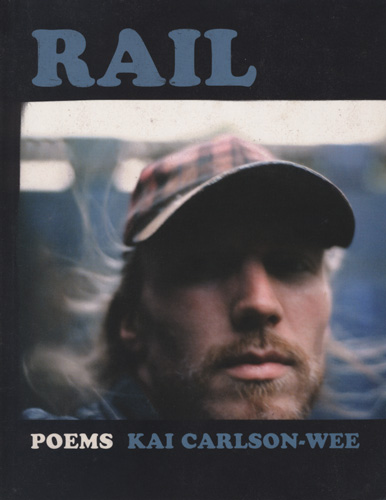Rail
Rail is epic. Yes, another barbaric yawp in the American song to the self. Full of food stamps and freight trains, Trader Joe’s dumpster diving, bullet shells in sewer drains, brotherhood, and prescription pills for depression, this collection is Kerouac, Ginsberg, Whitman, Sandburg, and O’Hara for the selfie generation.
Rail is epic. Yes, another barbaric yawp in the American song to the self. Full of food stamps and freight trains, Trader Joe’s dumpster diving, bullet shells in sewer drains, brotherhood, and prescription pills for depression, this collection is Kerouac, Ginsberg, Whitman, Sandburg, and O’Hara for the selfie generation.
The title poem “Rail” lets the reader know this is the canon we are conversing with:
We know the way the story ends.
Still, the whistle blows. The flare stacks whip
their excess methane candles against
the night, still churn the polished iron ash.
The road goes on.
Part travelogue, part confessional, the themes revolve around the landscapes rushing by in a flurry of youth. The audacity and innocence is commendable. In “Poet at Twenty Four,” the voice conjures a nostalgia well ahead of its age, “in those days the wind seemed to whittle me down . . . ” claiming a wisdom “at the Radio Shack in the mall,” or later in a coffeeshop “scribbling notes on a wrinkled receipt.” This is a mature voice embodied by youth, slipping through the hollow cracks of America, bound to a spiritual quest. Carlson-Wee is doing exactly what a poet should be doing: getting out there and discovering American. From Oxford alleys to Fargo soy fields, this is the un-downloadable America not seen on Google Maps.
Each poem stands alone and tumbles down the page, overflowing with detail, insight, and prayer. Reading Rail brings to mind comments written by Charles Simic in the Orphan Factory:
The quality of any experience depends on how aware we are of ourselves while it is taking place . . . Lyric poetry at its purest is the phenomenology and metaphysics of that moment and that consciousness. American poetry with its obsessive scrutiny and retelling of experience extends the ambitions of lyric poetry even farther.
Not only conversing with American poetry, he is aware of his place in the conversation. Imagine a bar band playing cover tunes and inventing lyrics. In “Northtown’s Choir,” a gang of drifters sit by a dying fire and erupt into song. The instruments are crude, found, “a railroad spike on a turned-over bucket,” a guy named Spider Eyes smacking a log, “a dude from Montana” on spoons, a dog whining. The narrator is swept up in rhythm, union, warmth, hope, “the dark trees nodding.” The vivid description and economy of telling is enough to paint a lyric scene, but when the narrator steps out of the scene, the verse really begins to fly:
I imagine the scene at a distance. A gang of marauders.
A wandering posse of infantrymen at the end of a third
world war. Not the two blond sons of a pastor,
the son of a physics professor from Phoenix, the son
of an auto-mechanic who beat him and gave him permission
to run away young. Not the fear we are only
pretending. The fading white scar over Spider Eyes’ eye.
Not the hunger we carried together. The wild
and lonely American moon we’ve already left behind.
These leaps of ascending awareness are what make the poems in Rail worthy of fine reading. Carlson-Wee masterfully sets each scene—careful with geography, bursting with unique detail, and then slipping in a universal reflection that transcends each movement. In the above poem, the fear of pretending. In “Heat Stroke in Redding,” two brothers are close to dehydration and dying for a lift to elsewhere. They revert to childhood memories of their mother, meatloaf, “the one chicken nugget gone bad,” and in slips, the gem; “how she just smiled / and let us imagine the victim was always / ourselves.” The scene closes with the two brothers promising to carry each other if the other passes out.
Alongside the vast rumble of train track and external moment, Rail also dissects emblematic family moments, usually as stories told. On the surface, the brothers are the main characters, yet the father, mother, grandmother, and Ant B—all keep the pages tumbling along. In “Splitting a Forty with Ant B,” a parable of aging and the consequences of life-choices—a guidance counselor at a Community College told Ant B she “slipped through the cracks”—tells a cautionary tale in dramatic monologue:
I grew up right here by the tracks. We had a nice
little homestead. A neighborhood. I like to come
back here. I got my privacy here. I got a beer and
tree-shadow. And the bugs ain’t too bad.
Sound like the epilogue to a Sam Shepard play. Ant B continues to talk about her life and watching zoos come in on a train. It is easy to imagine sitting under the tree with a cold beer, swatting flies, listening to the story. Capturing that stillness is no easy feat.
Rail by Kai Carlson-Wee is American saga full of clamor and acumen. The subtle shifts, the penchant for pre-earned nostalgia, the fear and loathing, the hope and love and joy of the simple and downtrodden—all highlight and amplify the beauty and horror of the American road and heart. Rail is youth discovering the world with guts and skill.





